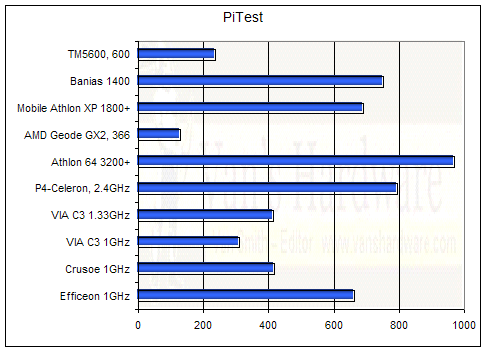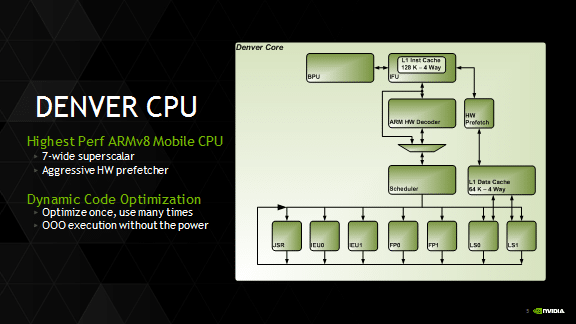ale tady nejde o efektivitu ve smyslu ultimátního výkonu, ale efektivitu energetickou, respektive
perf./watt. Stačí se podívat na testy Transmety Efficeonu. Při dané spotřebě vůbec nebyly špatné a
překonávaly VIA C7, která je nativním x86 CPU ! Navíc nejde o emulaci v pravém slova smyslu, výpočetní pipeline v CPU jsou fyzické, stejně tak cache a další části čipu. Instrukce ARM jsou interně překládány při velmi malé režii na instrukce Denveru (VLIW).
The greatest intelligence of Transmeta Crusoe processors plugged into the code morphing software CMS. Thus, the entire code of a computer architecture on the actual hardware is implemented at runtime. Only the code morphing software itself has access to the processor. The CMS optimizes and translates x86 instructions dynamically in native VLIW code. At runtime, the system is always faster because the code-morphing software tried every chain of command only once to translate. The translated VLIW code keeps the CMS then stored in memory.
dobře je to
popsáno zde

Efficeon comes in two package types: a 783- and a 592-contact ball grid array. Its power consumption is moderate (with some consuming as little as 3 watts at 1 GHz and 7 watts at 1.5 GHz), so it can be passively cooled.
With a good code morphing engine the CPU could regularly receive nice bundles of instructions that are already optimized for peak parallelism
These two VLIW molecules could potentially execute in fewer cycles than the original instructions could on an x86 processor.[3]
Transmeta claimed several technical benefits to this approach:
1.As the market leaders Intel and/or AMD would extend the core x86 instruction set, Transmeta could quickly upgrade their product with a software upgrade rather than requiring a respin of their hardware. This method just emphasises the compatibility rather than the performance.
2.Performance and power can be tuned in software to meet market needs.
3.It would be relatively simple to fix hardware design or manufacturing flaws in the hardware using software workarounds.
4.More time could be spent concentrating on enhancing the capabilities of the core or reducing its power consumption without worrying about 33 years of backward compatibility to the x86 architecture.
5.The processor could emulate multiple other architectures, possibly even at the same time. (At its initial Crusoe launch, Transmeta demonstrated pico-Java and x86 running intermixed on the native hardware.)
The T50 core is wide, very wide, 8 pipes wide in fact. Once you have picked your jaw up off the floor, let me just start by saying that the width is not equivalent to an 8 wide ARM core, this is 8 ‘Transmeta’ style software instructions, not ARM instructions. In the end, T50 should be about the performance equivalent of a 4-wide ARM core, a sensible target, with a lot lower power use.
Uvidíme, jak Denver dopadne až budou venku nějaké podrobnější testy, ale prvotní benchmark ukazuje, že je Denver rychlejší jak A57. Myslím, že Nvidia má pořád za lubem i emulaci jiného ISA než jen ARM. Díky "code morphing" by Denver mohl stejně dobře emulovat x86 ISA jako ARM a pak by takové rozhodnutí dávalo větší smysl.
Pokud by měl Denver zpracovávat pouze ARM instrukce, přijde mi nesmyslné emulovat ARM ISA pomocí code morphingu, když zde nejsou žádná licenční omezení a v podstatě každý, kdo si zaplatí patřičnou licenci si může navrhnout vlastní ARM jádro... U x86 ISA ale licenční omezení stále existují a tato "vlastnost" Denveru by mohla Nvidii pomoci vyzrát na Intel.
je zde ale jedna věc, která na tuto teorii vrhá poněkud stín. Když před zhruba třemi lety došlo k dohodě mezi Intelem a Nvidií, které vyústilo tučným odškodněním Nvidie ve výši 1 milardy dolarů v dohodě mimo jiné stál tento text:
“Intel Architecture Emulator” shall mean software, firmware, or hardware that, through emulation, simulation or any other process, allows a computer or other device that does not contain an Intel Compatible Processor, or a processor that is not an Intel Compatible Processor, to execute binary code that is capable of being executed on an Intel Compatible Processor.“
http://download.intel.com/pressroom/leg ... dacted.pdf
Teoreticky (legálně) tedy Denver může být i "x86" CPU, ale zřejmě by to bylo proti uzavřené dohodě s Intelem.
na druhou stranu:
Nvidia’s stance was that there was no need for any license because the company was not making x86 hardware. Technically, this is true, T50 is a software/firmware based ‘code morphing’ CPU like Transmeta. The ISA that users see is a software layer, not hardware, the underlying ISA can be just about anything that Nvidia’s engineers feel works out best. T50 is not x86 under all the covers, nor is it ARM, it is something else totally that users will never be privy to.







